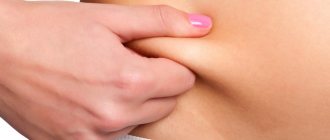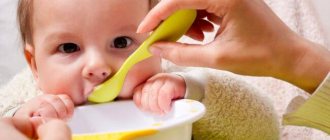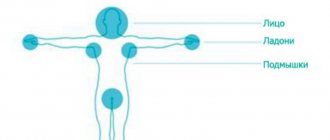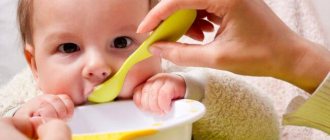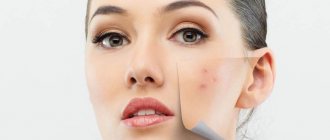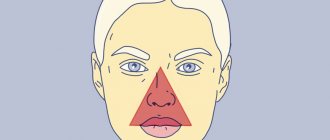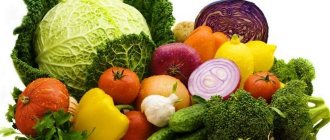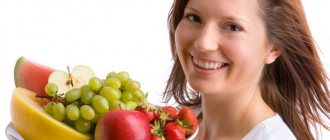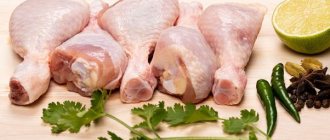General rules
Herpes infection is a highly contagious, widespread infection. Most infections occur in childhood, and then the virus remains in the body throughout life. When infected with herpes simplex virus type 1, the infection appears on the lips, around the mouth and inside, on the wings of the nose. In some cases, it can also cause genital herpes, which is caused by a type 2 virus .
The disease can be triggered by: hypothermia, stress, injury, bacterial infections, hypovitaminosis , overwork, menstruation, strict diets, exhaustion, cancer and excessive tanning. The diet for herpes, as for any infectious disease, is aimed at reducing the severity of signs of infection and has the following basic principles:
- Maintaining balance. Food that contains the required amount of microelements, vitamins, proteins, carbohydrates and fats increases the overall tone of the body and immunity . For protein foods, preference is given to lean meat, fish and dairy products. Carbohydrates should be replenished from complex carbohydrates found in cereals, vegetables, fruits, and whole grain products.
- The diet should be gentle on the liver: smoked, spicy and fried foods, salty foods, spices, canned food and rich broths are excluded.
- Mandatory introduction of fermented milk products with bifidobacteria . They help restore intestinal microflora, which has a beneficial effect on the immune system.
- For all diseases, alcohol consumption is excluded, the consumption of which aggravates the course of the disease.
It has also been proven that a number of foods can trigger relapses:
- excess sugar;
- alcohol, especially beer;
- arginine in food and lack of lysine .
It has been found that the herpes virus “wakes up” and rashes appear on the lips or other parts of the body if food contains large amounts of the amino acid arginine , which is found in all nuts (most of all in peanuts), raisins, wheat, gelatin, chocolate, seeds and sunflower seeds ( Pumpkins are the leaders in this regard). The risk of exacerbation increases if foods with arginine (especially excess grains or nuts) are consumed for several days.
Conversely, the amino acid lysine effectively inhibits the multiplication of the virus, lengthens the period of remission, and prevents relapses. It also has a mild antidepressant effect, reduces anxiety and irritability. The daily requirement of lysine for adults is 23 mg/kg of body weight (for an adult weighing 80 kg this is 1840 mg). Our body absorbs only L-lysine and for its more complete absorption the presence of vitamins A , C , B1 and iron is necessary. With insufficient intake of this amino acid in the body, lethargy, nervousness occurs, appetite decreases, anemia develops and viral diseases recur. Stress depletes the cell's lysine reserves and the herpes virus is activated, which explains why people under stress are more likely to have relapses.
Dairy products
Both amino acids are present in foods and are good for health, but a bias towards arginine in the diet (muesli, peanuts, wheat flour, refined pasta) causes recurrent herpes in people predisposed to it. But this only happens with a lack of lysine.
Therefore, nutrition for herpes on the body and other localizations of the process should contain foods rich in lysine, and sometimes you even need to take lysine in the form of supplements (1250 mg is a prophylactic dose, and during an exacerbation it increases to 3000 mg).
Lysine is found in large quantities in:
- dairy products (including cheeses, soft cheeses and cottage cheese);
- rabbit, chicken, turkey;
- red meat (lamb, beef, veal and less in pork);
- fish (sardine, cod, tuna, squid, sea bass, carp, herring, pollock);
- eggs;
- soybeans, beans, peas.
Cereal products (wheat, corn) have low lysine content. Cereals lose it during processing (grinding). Lysine is also destroyed when preparing protein products with added sugar. You need to switch to a “lysine” diet during an exacerbation of the disease or when you feel that there is a danger of relapse (for example, after hypothermia, stress).
During this period, it is contraindicated to consume foods in which the arginine content is several times higher than the lysine content. Products are arranged in descending order of their content of this amino acid:
- pumpkin seeds;
- sesame seed;
- peanut;
- almond;
- snails;
- Pine nuts;
- walnuts;
- dried peas;
- shrimps;
- tuna;
- anchovies;
- crabs;
- chicken fillet
- pork;
- liver;
- beef
- flounder;
- chocolate;
- raisin;
- cereals, white bread;
- gelatin (dishes containing it);
- rice;
- corn flour.
It has been proven that the use of lysine helps to lengthen the relapse-free period for various types of herpes, including genital herpes. With this form, symptoms may be absent or minor. Most infected people do not even know they have the infection. During an exacerbation, blisters or sores appear in the genital area, and there are often chills, aches and inflammation of the lymph nodes.
Infection with the virus lasts a lifetime and cannot be treated. Repeated relapses are less intense and their frequency decreases over time. In addition to general nutritional recommendations, it is very important to maintain sexual rest during an exacerbation period. It must be borne in mind that transmission of the virus is also possible through the skin of the patient’s genitals, which looks healthy, and there may even be no symptoms.
Herpes zoster (or shingles) is caused by the Herpes zoster virus, which attacks nerve endings. This is accompanied by inflammation of the skin in the area of the affected nerve, severe pain and rashes. Usually there is damage to the intercostal nerves and the process is localized in the chest area. The disease manifests itself against a background of stress, overwork, and decreased immunity.
With herpes zoster, especially in the case of frequent recurrences, you need to pay attention to nutrition. It is no different from the above, but since this disease causes more pronounced skin lesions, it is worth including foods with a high zinc content in your diet: liver, beef, legumes, seafood, wheat germ oil, beef and lamb, whole grains (buckwheat, pearl barley , oat).
Since the persistent course of the disease is observed with hypovitaminosis and decreased immunity, the diet should be complete and contain:
- A sufficient amount of proteins (dairy products, cottage cheese, meat, fish). The diet includes lean meat and fish, which are more preferable as a source of omega 3 acids (sardine, cod, tuna, halibut).
- Antioxidant vitamin E , which can be obtained by consuming vegetable oils, oat and buckwheat, dried apricots, prunes, sea buckthorn, rose hips, wheat germ, spinach, viburnum.
- B vitamins that help increase the body's resistance and improve metabolic processes: sprouted cereal sprouts, brewer's yeast, brown rice, whole grain baked goods, soybeans, broccoli, lettuce, buckwheat and millet cereals, lentils, liver, beef, fish , eggs, brown rice, beans.
- Vitamin A : fish oil, animal liver, cod liver.
- Vegetables and fruits are suppliers of the antioxidant vitamin C : strawberries, melon, broccoli, green salads, Brussels sprouts, bell peppers, black currants, rose hips, strawberries, apples, apricots, peaches.
- In order to reduce the load on the liver, the diet for herpes includes the exclusion of fried and spicy foods, smoked foods, strong broths, coffee, marinades and sauces.
What is the essence of following a diet and is it really necessary?
Many can simply wave their hand and say that the devil is not as terrible as he is painted. However, it’s worth learning at least once about the consequences of herpes to change your mind forever.
In an advanced state, visually visible blisters are only a small part of the existing problem; in fact, the infection can affect the lymph nodes, lungs, intestines, liver, kidneys, heart, blood vessels, internal genital organs, etc. If it spreads to the membranes of the brain, it can even occur remain disabled or end your life with death.
Having looked through these “passion-faces”, we still make a reasonable choice and return to proper nutrition. Why is it so useful:
- immunity is strengthened;
- the level of acidity in the body decreases;
- growth and regeneration of tissue structure is ensured;
- the production of hormonal and enzymatic substances is restored;
- prevention of vitamin deficiencies is provided;
- the overall well-being and health of a person improves.
Attention: including a balanced diet in your usual lifestyle is part of the comprehensive treatment of herpes, as a result of which we simply “drive” the virus into a long latent form of progression.
Healthy diet
You can learn more about the possibilities of proper nutrition from the video in this article.
Rules for rational nutrition
Now I would like to note a few strict rules that simply must be followed during a diet for herpes:
- the food is gentle, the type of heat treatment is encouraged - steamed, boiled, stewed and grilled;
- mandatory exclusion of spicy, smoked, salted, fried foods, canned food, spices and fatty rich broths;
- maintaining optimal balance (food must contain the required amount of vitamins, microelements, carbohydrates, fats and proteins, this improves immunity and overall tone of the body);
- you should stop consuming excess sugar and easily digestible carbohydrates, which only promote the growth of pathogenic microorganisms and slow down the rate of absorption of vitamin C and group B;
- maintaining normal water balance (drink at least 1.5 liters of clean water per day);
- meals are fractional, dividing the permissible portion per day into several times.
Sometimes during a diet a very sensitive question arises: can you drink alcohol if you have herpes?
In this case, the answer is obvious - alcohol-containing drinks are harmful not only for this disease, but also for health in general. If this fact is very difficult, then at least eliminate alcohol at the time of relapse for at least 2 months, or better yet, think about replacing it with healthier drinks - herbal teas, natural juices, mineral water, etc.
Basic requirements for a balanced diet
NO to alcohol
Authorized Products
- It is better to cook soups in vegetable broth with the addition of vegetables. Strong broths should be excluded during an exacerbation period (secondary broth can be used).
- Bread made from whole grain flour, rye, bran, and bran bread is consumed in a limited manner.
- Meat products include rabbit, veal, beef, turkey or chicken. They are boiled or baked.
- Allowed types of fish (carp, herring, pollock, sea bass, sardine, cod, tuna and squid) are also boiled, baked or stewed. Fish should be present in the diet daily.
- Dairy products, cottage cheese and cheeses should also be in the diet every day. You should give preference to natural yogurt with bifidobacteria .
- All vegetables and greens, legumes (beans, soybeans, lentils) are allowed. Considering that the value of fresh vegetables is greater, the diet should mainly consist of them. Use various vegetable oils in salads. Include fruits in your diet every day.
- You can eat boiled chicken and quail eggs.
- All cereal products are limited during exacerbation. Whole grains (buckwheat) are allowed, processed wheat products (wheat, semolina) and white rice are excluded.
- Pasta is allowed to a limited extent and only made from whole grain flour.
- Any drinks: green tea, weak tea with milk, natural juices, herbal infusions, compotes, rosehip infusion.
Table of permitted products
| Proteins, g | Fats, g | Carbohydrates, g | Calories, kcal | |
Vegetables and greens | ||||
| vegetables legumes | 9,1 | 1,6 | 27,0 | 168 |
| eggplant | 1,2 | 0,1 | 4,5 | 24 |
| zucchini | 0,6 | 0,3 | 4,6 | 24 |
| cabbage | 1,8 | 0,1 | 4,7 | 27 |
| Brussels sprouts | 4,8 | 0,0 | 8,0 | 43 |
| cauliflower | 2,5 | 0,3 | 5,4 | 30 |
| potato | 2,0 | 0,4 | 18,1 | 80 |
| carrot | 1,3 | 0,1 | 6,9 | 32 |
| cucumbers | 0,8 | 0,1 | 2,8 | 15 |
| salad pepper | 1,3 | 0,0 | 5,3 | 27 |
| radish | 1,2 | 0,1 | 3,4 | 19 |
| white radish | 1,4 | 0,0 | 4,1 | 21 |
| salad | 1,2 | 0,3 | 1,3 | 12 |
| beet | 1,5 | 0,1 | 8,8 | 40 |
| soybeans | 34,9 | 17,3 | 17,3 | 381 |
| soybeans (sprouts) | 13,1 | 6,7 | 9,6 | 141 |
| tomatoes | 0,6 | 0,2 | 4,2 | 20 |
| pumpkin | 1,3 | 0,3 | 7,7 | 28 |
Fruits | ||||
| apricots | 0,9 | 0,1 | 10,8 | 41 |
| pineapples | 0,4 | 0,2 | 10,6 | 49 |
| watermelon | 0,6 | 0,1 | 5,8 | 25 |
| pomegranate | 0,9 | 0,0 | 13,9 | 52 |
| pears | 0,4 | 0,3 | 10,9 | 42 |
| melon | 0,6 | 0,3 | 7,4 | 33 |
| nectarine | 0,9 | 0,2 | 11,8 | 48 |
| peaches | 0,9 | 0,1 | 11,3 | 46 |
| apples | 0,4 | 0,4 | 9,8 | 47 |
Berries | ||||
| blackberry | 2,0 | 0,0 | 6,4 | 31 |
| strawberry | 0,8 | 0,4 | 7,5 | 41 |
| raspberries | 0,8 | 0,5 | 8,3 | 46 |
| sea buckthorn | 1,2 | 5,4 | 5,7 | 82 |
| black currant | 1,0 | 0,4 | 7,3 | 44 |
Nuts and dried fruits | ||||
| dried apricots | 5,2 | 0,3 | 51,0 | 215 |
| prunes | 2,3 | 0,7 | 57,5 | 231 |
Cereals and porridges | ||||
| buckwheat (kernel) | 12,6 | 3,3 | 62,1 | 313 |
Raw materials and seasonings | ||||
| milk sauce | 2,0 | 7,1 | 5,2 | 84 |
| sour cream sauce | 1,9 | 5,7 | 5,2 | 78 |
Dairy | ||||
| kefir | 3,4 | 2,0 | 4,7 | 51 |
| sour cream | 2,8 | 20,0 | 3,2 | 206 |
| curdled milk | 2,9 | 2,5 | 4,1 | 53 |
Cheeses and cottage cheese | ||||
| cheese | 24,1 | 29,5 | 0,3 | 363 |
| parmesan cheese | 33,0 | 28,0 | 0,0 | 392 |
| cottage cheese | 17,2 | 5,0 | 1,8 | 121 |
Meat products | ||||
| pork liver | 18,8 | 3,6 | 0,0 | 108 |
| beef | 18,9 | 19,4 | 0,0 | 187 |
| beef liver | 17,4 | 3,1 | 0,0 | 98 |
| veal | 19,7 | 1,2 | 0,0 | 90 |
| rabbit | 21,0 | 8,0 | 0,0 | 156 |
Bird | ||||
| chicken | 16,0 | 14,0 | 0,0 | 190 |
| turkey | 19,2 | 0,7 | 0,0 | 84 |
Eggs | ||||
| chicken eggs | 12,7 | 10,9 | 0,7 | 157 |
Fish and seafood | ||||
| squid | 21,2 | 2,8 | 2,0 | 122 |
| carp | 16,0 | 5,3 | 0,0 | 112 |
| pollock | 15,9 | 0,9 | 0,0 | 72 |
| sea bass | 15,3 | 1,5 | 0,0 | 79 |
| sardine | 20,6 | 9,6 | — | 169 |
| herring | 16,3 | 10,7 | — | 161 |
| cod | 17,7 | 0,7 | — | 78 |
| tuna | 23,0 | 1,0 | — | 101 |
Oils and fats | ||||
| peasant unsalted butter | 1,0 | 72,5 | 1,4 | 662 |
| wheat germ oil | 0,0 | 100,0 | 0,0 | 884 |
| linseed oil | 0,0 | 99,8 | 0,0 | 898 |
| olive oil | 0,0 | 99,8 | 0,0 | 898 |
Non-alcoholic drinks | ||||
| mineral water | 0,0 | 0,0 | 0,0 | — |
| green tea | 0,0 | 0,0 | 0,0 | — |
Juices and compotes | ||||
| juice | 0,3 | 0,1 | 9,2 | 40 |
| rose hip juice | 0,1 | 0,0 | 17,6 | 70 |
| * data is per 100 g of product | ||||
Fully or partially limited products
- All types of nuts, sesame and other seeds, pumpkin and sunflower seeds.
- Fried foods, smoked meats, pickled vegetables, canned food, sausages, any semi-finished products.
- Chocolate, gelatin-based dishes, flour products.
- Citrus.
- Alcohol.
- Highly extractive dishes (broths) are excluded.
- Simple carbohydrates (sugar, jam, sweet pastries, cakes, jams, pastries with cream, sweets).
Table of prohibited products
| Proteins, g | Fats, g | Carbohydrates, g | Calories, kcal | |
Vegetables and greens | ||||
| canned vegetables | 1,5 | 0,2 | 5,5 | 30 |
| pickled cucumbers | 2,8 | 0,0 | 1,3 | 16 |
| tomatoes | 0,6 | 0,2 | 4,2 | 20 |
| pickled tomatoes | 1,7 | 0,2 | 1,8 | 15 |
| horseradish | 3,2 | 0,4 | 10,5 | 56 |
Fruits | ||||
| oranges | 0,9 | 0,2 | 8,1 | 36 |
| grapefruit | 0,7 | 0,2 | 6,5 | 29 |
| lemons | 0,9 | 0,1 | 3,0 | 16 |
| persimmon | 0,5 | 0,3 | 15,3 | 66 |
Nuts and dried fruits | ||||
| peanut | 26,3 | 45,2 | 9,9 | 551 |
| walnuts | 15,2 | 65,2 | 7,0 | 654 |
| raisin | 2,9 | 0,6 | 66,0 | 264 |
| Pine nuts | 11,6 | 61,0 | 19,3 | 673 |
| cashew | 25,7 | 54,1 | 13,2 | 643 |
| sesame | 19,4 | 48,7 | 12,2 | 565 |
| almond | 18,6 | 57,7 | 16,2 | 645 |
| hazel nuts | 13,1 | 62,6 | 9,3 | 653 |
| flax seeds | 18,3 | 42,2 | 28,9 | 534 |
| sunflower seeds | 20,7 | 52,9 | 3,4 | 578 |
| pumpkin seeds | 24,5 | 45,8 | 4,7 | 556 |
| pistachios | 20,0 | 50,0 | 7,0 | 556 |
Cereals and porridges | ||||
| cereals | 11,9 | 7,2 | 69,3 | 366 |
| Wheat groats | 11,5 | 1,3 | 62,0 | 316 |
| white rice | 6,7 | 0,7 | 78,9 | 344 |
Flour and pasta | ||||
| sesame flour | 45,0 | 12,0 | 32,0 | 462 |
Bakery products | ||||
| wheat bread | 8,1 | 1,0 | 48,8 | 242 |
Confectionery | ||||
| pastry cream | 0,2 | 26,0 | 16,5 | 300 |
| cake | 3,8 | 22,6 | 47,0 | 397 |
| shortbread dough | 6,5 | 21,6 | 49,9 | 403 |
Cakes | ||||
| cake | 4,4 | 23,4 | 45,2 | 407 |
Chocolate | ||||
| chocolate | 5,4 | 35,3 | 56,5 | 544 |
Raw materials and seasonings | ||||
| mustard | 5,7 | 6,4 | 22,0 | 162 |
| ketchup | 1,8 | 1,0 | 22,2 | 93 |
| mayonnaise | 2,4 | 67,0 | 3,9 | 627 |
| honey | 0,8 | 0,0 | 81,5 | 329 |
| ground black pepper | 10,4 | 3,3 | 38,7 | 251 |
| chilli | 2,0 | 0,2 | 9,5 | 40 |
Meat products | ||||
| pork | 16,0 | 21,6 | 0,0 | 259 |
Sausages | ||||
| dry-cured sausage | 24,1 | 38,3 | 1,0 | 455 |
Bird | ||||
| smoked chicken | 27,5 | 8,2 | 0,0 | 184 |
| duck | 16,5 | 61,2 | 0,0 | 346 |
| smoked duck | 19,0 | 28,4 | 0,0 | 337 |
| goose | 16,1 | 33,3 | 0,0 | 364 |
Fish and seafood | ||||
| dried fish | 17,5 | 4,6 | 0,0 | 139 |
| smoked fish | 26,8 | 9,9 | 0,0 | 196 |
| canned anchovies | 20,1 | 6,1 | 0,0 | 135 |
| pink salmon | 20,5 | 6,5 | 0,0 | 142 |
| Red caviar | 32,0 | 15,0 | 0,0 | 263 |
| black caviar | 28,0 | 9,7 | 0,0 | 203 |
| crab meat | 6,0 | 1,0 | 10,0 | 73 |
| canned fish | 17,5 | 2,0 | 0,0 | 88 |
| salmon | 21,6 | 6,0 | — | 140 |
| trout | 19,2 | 2,1 | — | 97 |
Oils and fats | ||||
| creamy margarine | 0,5 | 82,0 | 0,0 | 745 |
| animal fat | 0,0 | 99,7 | 0,0 | 897 |
| cooking fat | 0,0 | 99,7 | 0,0 | 897 |
Alcoholic drinks | ||||
| beer | 0,3 | 0,0 | 4,6 | 42 |
Non-alcoholic drinks | ||||
| bread kvass | 0,2 | 0,0 | 5,2 | 27 |
| Pepsi | 0,0 | 0,0 | 8,7 | 38 |
| sprite | 0,1 | 0,0 | 7,0 | 29 |
| tonic | 0,0 | 0,0 | 8,3 | 34 |
| Fanta | 0,0 | 0,0 | 11,7 | 48 |
| * data is per 100 g of product | ||||
Menu (Power Mode)
Taking into account the recommended products, you can create a menu. High lysine content is found in rabbit meat, turkey meat, soybeans, beef, veal, chicken, squid, sea bass, carp, herring, pollock, dairy products and cheeses. These products can be used to create a varied diet. At the same time, dairy products and vegetables are not limited and should be present at every meal.
Enrich your meals with cold-pressed vegetable oils, and use fruits and yoghurts for snacks. Cereal dishes are limited only during the period of exacerbation of the disease, and during the period of remission they should be included in the diet.
The most beneficial and less beneficial foods for herpes
With a balanced and organized diet, the state of the immune system, mucous membranes and skin is normalized, and performance improves. Intestinal peristalsis and the level of acidity in the body are also stabilized, which significantly reduces the risk of exacerbations and speeds up recovery in the event of a relapse.
To do this, you just need to pay attention to the following products:
- eggs;
- lean fish and seafood;
- soy based food;
- skim milk, yogurt, cottage cheese;
- potato;
- brewer's yeast;
- wheat germ;
- greens, fruits and vegetables enriched with phytoncides;
- sea cabbage.
Healthy foods
You should also know what you should not eat if you have herpes:
- bakery products;
- strong tea and coffee;
- alcoholic drinks (have a toxic effect);
- peanuts, nuts, legumes, sunflower seeds;
- gelatin and chocolate;
- whole grains;
- fatty meats;
- sugar and salt in large quantities.
Such recommendations are suitable for every person who has the herpes virus in their body, and such people, for a moment, are about 90% of the entire population, and some citizens are bothered by it with sad frequency, while others experience an exacerbation of the infection only once every few years.
Unhealthy food
Reviews and results
There are few restrictions in this diet and foods can be prepared in many ways. The diet is healthy and nutritious, and temporary restriction of cereal products does not affect health. The only negative, according to patient reviews, is the limitation of sweets. Women especially have a hard time with the lack of sweets, cakes, and chocolate, and this is the main reason for not following the diet to the end.
- “... In my own experience, I noticed that rashes most often appear after eating grapes, nuts, herring and scrambled eggs, although eggs are allowed. Real, rustic cottage cheese helps most effectively. I don’t trust store-bought ones and buy them at the market. In general, you need to strengthen your immune system (immunal or echinacea, vitamins) and not be nervous. When the stress at work ended and the herpes subsided. I started to harden up, I go to the pool and everything is fine with my health”;
- “... After childbirth, the immune system weakened. 1.5 years have already passed and herpes on the lips does not give me peace. If before it was once a year, now it’s every 2 months. I’m worried about the child (I’m afraid of infecting the baby), so I decided to take care of myself. First of all, I take vitamins and Proteflazid. Then I added L-lysine in capsules. He even has suitable indications: herpes infection, decreased immunity, neuroses and irritability - what I need. Finally, I started sticking to a diet. 7 months have already passed and everything is fine with me. Apparently everything works together!”;
- “... I had rashes on my lips 4-5 times a year, a course of Geviran helped and everything has been fine for 2 years now. But when there was stress at work, and even hypothermia, he jumped out again. I haven’t tried nutrition, it may help, but if you need to quickly recover, then there is no time for experiments. I often apply Acyclovir and it goes away in 3 days. In principle, you can try drinking lysine and eating a lot of cottage cheese and milk - I love them.”
Diet depending on the type of herpes
If you read carefully, then at the very beginning we said that there are several types of herpes. Therefore, we decided to offer various diet options depending on the problem at hand.
Infection on the lips
The most harmless type of disease.
The essence of dietary nutrition in this case consists of the following points:
- After sleep, be sure to drink a glass of clean water, preferably mineral water.
- You can have cottage cheese with the addition of pieces of fruit for breakfast, and as an aperitif, eat one piece of sandwich and wash it down with green tea.
- Snack before lunch with an apple, banana or pear.
- For lunch, eat a vegetable salad and low-fat soup, and to quench your thirst, you can drink jelly, fruit juice, compote or fruit drink.
- Low-fat yogurt is good for an afternoon snack.
- For dinner, it is better to give preference to porridge with milk, pilaf or durum wheat pasta.
- Before going to bed, drink kefir or fermented baked milk.
The main thing to remember is that 50% of the total diet should consist of foods such as potatoes, carrots, beets, bran and oatmeal. It is necessary to saturate the body with proteins by 30% in the form of low-fat varieties of meat products and seafood. The remaining 20% is the consumption of fats in the form of dairy products, olive, butter or sunflower oil.
Attention: special preference should be given to fresh fruit crops, the most useful of which are apricots, lingonberries, peaches, blueberries and cranberries, especially since the price for them during the season is not so high.
Herpes on the lips
Herpes genital
The diet for genital herpes should be aimed at strengthening the immune system and eliminating the infection that provokes an exacerbation of the pathology. A balanced diet accelerates the regeneration of damaged tissue structures, which leads to a quick recovery. The diet mainly consists of dairy products, fish dishes and seafood.
As an example menu, we offer you this option:
- For breakfast, cottage cheese and a glass of tea.
- Before lunch, a milkshake with pieces of fresh berries or fruit added.
- At lunchtime, prepare chicken salad and seafood (shrimp) soup.
- One apple as an afternoon snack.
- For dinner, mashed potatoes and baked pollock.
- A glass of milk before bed.
You should definitely avoid foods that promote the spread of infection. These are sweets, flour, baked goods and carbonated drinks.
The duration of the diet is at least 2 weeks. Also, do not forget about hygiene measures and drug therapy that the doctor prescribed for you at the appointment.
Herpes on the genitals
Herpes zoster
The diet should help reduce the activity of the virus and restore immunity. The menu is no different from previous versions, but, nevertheless, extensively damaged skin needs a sufficient supply of zinc to the body, which is found in seafood, lamb and beef, and wheat germ.
An approximate daily version of proper nutrition will look like this:
- Breakfast . A glass of tea and a steamed omelette.
- Before lunch . Fresh fruit salad.
- Dinner . Vegetable soup based on meat broth, mashed potatoes and a steamed cutlet.
- Afternoon snack . 2 oranges.
- Dinner . Seafood salad, a piece of grilled lean fish.
- Before bedtime . 1 glass of kefir.
It is very important to understand that a balanced and properly selected diet for herpes does not destroy the virus, but only makes it less active. After the disease goes into remission, it is best to follow the diet for another two weeks, and then return to a familiar diet, but with some reservations, which we mentioned just above.
Herpes zoster
Taking into account the recommendations presented, you can create a varied daily menu that suits different taste preferences of a person. The only disappointment may be the limitation of sweets, but at such a moment you just need to think about the benefits of this aspect and the small advantages in the form of a slender, beautiful figure and herpes-free skin.

